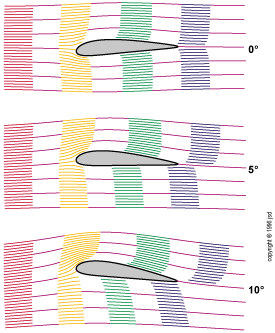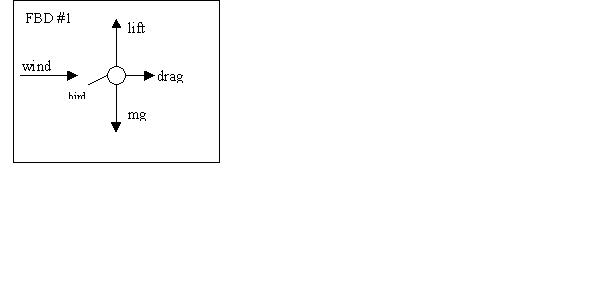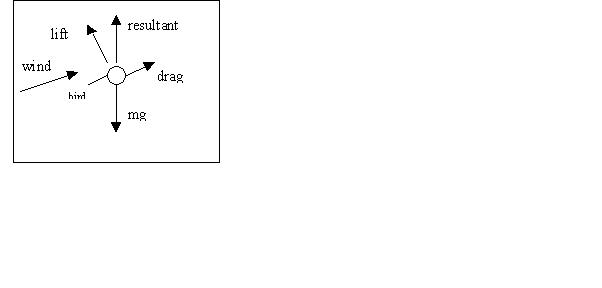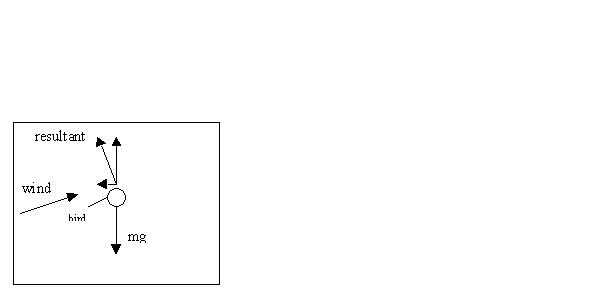
| MadSci Network: Physics |
Dear Josh,
I really wasn't sure how to proceed with this question as I am not an Aeronautical Engineer. However, I gave it some thought and came up with what I felt is a plausible explanation. I did a little searching on airfoil design and found some interesting things, mostly to do with arguments on the theory of how airplanes fly. They were interesting and give some good background, but really didn't address your question. The argument is between Bernoulli lift (lower pressure do to higher air velocity on upper surface of wing) and Newtonian physics of air being forced downward due to the upward angle of attack of the wing.
http://www.eskimo.com/~billb/wing/airfoil.html
My take is that it is a combination of the two, but regardless, the resulting forces can still be divided into components of lift and drag, regardless of how they are caused. (See first illustration of flow vs. angle of attack).

So this leads me to think of how a bird can stay stationary in mid air. Most engineers, when faced with any problem of forces and motion, draw a free body diagram (FBD) to represent the whatever object is in question. So a plane, or bird, or flying squirrel can be represented as a small mass that is subject to the forces around it. This includes gravity and the aforementioned drag and lift. In a completely horizontal wind, the air flow essentially comes into the airfoil as flat lines. (You have likely seen this in wind tunnel pics and is like the lines in the first pic). Now the second illustration shows these three forces on the bird wing. You will see there are no forces forward, and changing the airfoil (wing) attack angle will increase drag and yield little or no change in the direction of the lift vector. This means that the forces can't balance each-other out and the object will move backwards without some forward force, such as a propeller or flapping. In short, this means I cannot think of a way that in TRUE horizontal flow a bird (or plane) can glide motionless.

Then how can you explain why we both have seen birds hover, and even move forward, in the way that you have described. There is a large clue (IMHO) in WHERE you see such phenomena. The only answer I could come up with is that the air flow is NOT completely horizontal, but actually rising. It has been my experience (and possibly yours) that you will be very hard pressed to find a bird hovering completely still on very flat land or in the middle of a large lake or ocean. Wind flow tends to be horizontal in these places (although large enough waves will cause intermittent updrafts that some birds use). The occurrences you describe tend to take place in hilly areas, or on the edges of canyons, or edges of lakes where water turns to land. All of these areas are places of updrafts. So I made a free body diagram of a bird with the wind rising upwards at an angle instead. Now you can see that the lift force is slightly forward, the drag at the same angle as the wind, and gravity splits the two. Now if lift is great enough and at a sufficient angle to offset the drag, the resultant vector between the two forces will cancel out the force of gravity, leaving a net force of zero on the bird, which means it will be stationary. (I am assuming that you know how to deal with vectors. If not, please ask one of your professors). By varying its angle of attack and wing shape, a bird can balance these forces and stay aloft. This is similar to what gliders do, but they need to maintain forward momentum for adequate lift. An advantage that birds have is quickly changing the shape and characteristics of their airfoil (wing).

Then how do they move forward? The last illustration shows that instead of the resultant vector of drag and lift being exactly opposite gravity (as in the previous free body diagram), it is pointing slightly forward. Then the 90-degree components can be shown with a small force going forward and the other opposite gravity. If the bird can quickly adjust its lift and drag characteristics as well as angle of attack, it can move the lift/drag vector slightly as well as increasing its magnitude. The increase in magnitude not only will give a slight forward force, but enables the other 90-degree component to still be enough to overcome the force of gravity.

This is only from my mind, with little backup, but it makes logical sense to me. Some Aero Engineer may dispute it, but I will still bet that this phenomena only occurs in regions of up-drafts (even slight ones) and not during true horizontal flow. This is the only solution I can come up with. And some birds may only need a small updraft, and it would be hard for us to determine if such an updraft exists without an array of wind meters.
Take care and best of luck in pilot school.
BK
Try the links in the MadSci Library for more information on Physics.